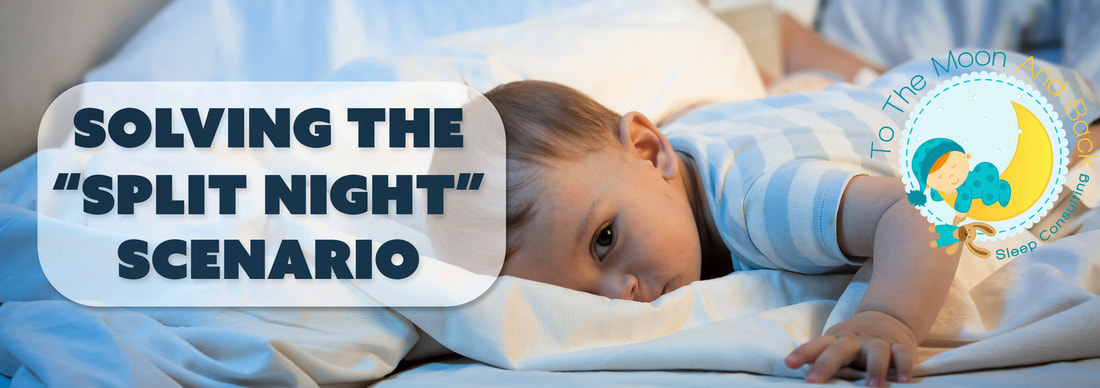|
Is your little one waking up in the middle of the night? No, no, not like that. I mean, like really waking up. Waking up and staying up. For, like… hours. If you’re the parent of a baby or toddler who’s dealing with segmented sleep, you know exactly what I’m talking about. This isn’t the middle of the night. “Go in and comfort your little sleeper for ten minutes until he gets back to sleep” wake up. This is a full-blown 3:00 a.m. dance party. It’s got a few names. Segmented sleep, bifurcated sleep, split nights, and it describes a situation where your little one sleeps for a long stretch, then wakes up happy and energetic in the middle of the night and stays that way for an hour or more. Slit Nights aren’t a new or unnatural phenomenon. Back before the widespread use of the electric light bulb, people would regularly sleep for a few hours, wake up for another hour or two, then go back to sleep. They’d use the time to read, smoke, pray, and have sex (not necessarily all at once), and then after an hour or two, they’d get back into bed and sleep until morning. (Apparently, it was also a typical time for visiting one’s neighbours. Not to hate on the old days, but if my neighbours came over unannounced at three in the morning, oooohhh, things would get biblical.) Nowadays, however, the vast majority of us go to sleep at night and, hopefully, close our eyes and sleep straight through until morning. But let me guess… your kiddo didn’t get the memo? Split nights are actually a pretty common issue. Baby goes down at 7:30 at night, wakes up at 3:00 in the morning, parties her ass off for an hour and a half, then goes back to sleep, apparently careless about the groggy, miserable day she’s set her parents up for. So let’s take a quick look at why this happens, and then we’ll learn how to solve the problem. Why Do Split Nights Happen? There are two major drivers when it comes to sleep. First, there’s our circadian rhythm, which is our natural tendency to fall asleep when it’s dark and wake up when it’s light. Then there’s our homeostatic sleep drive, commonly known as sleep pressure, which builds up over the time we’re awake. So ideally, over the course of the day, sleep pressure builds up, then at bedtime, when the pressure hits the sweet spot, baby puts her head down and goes to sleep. Then, as that sleep pressure begins to subside, circadian rhythm takes over, and baby stays asleep until morning. In the case of a split night, we could be looking at one of two reasons why they’re waking up. ● Your baby or toddler is not getting to bed early enough, OR… ● She is going to bed too early. Now before you pitch your phone out the window at that seemingly paradoxical explanation, check this out. How to Fix Split Nights? If your little sleeper is getting to bed too late, if too much sleep pressure has built up, the brain has this instinctive response that says, “Hey, you’re tired, but you’re not sleeping. I’m guessing that’s because there’s a carnivorous apex predator around, so we’d better get ready to make a break for it,” and then starts upping the cortisol levels. The brain means well, but it’s a little behind the times on our need for lion alerts. So this can make it tough for baby or toddler to get to sleep at bedtime since that cortisol’s got them a little bit jacked. It can also cause a full wake-up at the end of a sleep cycle, which commonly happens around 2 or 3 in the morning. Ugh. If this is the case, you’re one of the lucky ones. Treat this like any other nighttime wake-up, reassure baby that it’s still bedtime, comfort her and let her get back to sleep on her own, and consider moving bedtime up a bit over the course of a few nights. But then there’s the alternate scenario. What if your little sleeper gets to bed too early? In a situation where your baby or toddler’s getting lots of quality daytime sleep and going to bed early, it’s possible that there’s not enough sleep pressure built up to keep him sleeping until his circadian rhythm takes over and helps him sleep through the rest of the night, so up he gets. And now that there isn’t as much sleep pressure, and their circadian rhythm doesn’t have the horsepower to get them to sleep on their own, suddenly they’re up and active for an hour (or three!) while that pressure builds back up. Now, I’m all about early bedtimes. Too little sleep is a much bigger problem than too much. But suppose your baby or toddler's experiencing this kind of split-night sleep. In that case, it’s worth looking at their schedule and doing a little fine-tuning to ensure that you’re hitting the optimum sleep pressure right at the same time that baby’s going to bed for the night. I know plenty of situations can arise where you’ll want to get baby to bed a little early. For example, if she had a day of lousy naps and is clearly tired half an hour before bedtime, it’s the right move to get her to bed ahead of schedule. But try to avoid putting your little sleeper to bed early, more than one or two nights in a row. We want to prevent over-tiredness, but we also don’t want them in the crib at night for more time than they’re actually capable of sleeping. So if your baby or toddler's had a tough day and didn’t nap well, it’s fine to get her to bed a little early since that sleep pressure is likely already built up, but try to get her back onto the regular schedule starting the next morning, including her wake-up time. I know that this can all start to sound like an immaculately choreographed ballet. In some ways, it can be pretty complicated. Still, the more you understand the nuances and know where to make those minor adjustments, the better your baby or toddler will sleep. The less they’ll run into these regressions, setbacks, and interruptions. One final thing to consider if you’re getting ready to tackle this situation. This is not likely to be an overnight fix. Once your little one has gotten into this habit, getting them out of it can take some time. Like any attachment or dependency, overcoming it is an incremental process, and it’s likely to meet with some pushback, so if and when things get tough, remember your goal. You’re giving your little one the skills they need to sleep soundly through the night, and that contributes to their well-being in so many different ways. So stay consistent, be patient, and before too long, you and your little sleeper will both be enjoying full nights of deep, restful sleep. If you are having trouble with your child's schedule and are unsure what it should look like get our Free Sleep Needs Chart. It will help you determine wake windows, nap lengths, number of naps, bedtimes, along with wait times for night time interventions. AuthorErin Neri - Certified Pediatric Sleep Consultant and Owner of To The Moon and Back Sleep Consulting since 2016. |
To The Moon and Back Sleep ConsultingProviding families the tools & support they need to get their little ones sleeping through the night and napping like champs! Everyone has more fun when they are well rested! Visit Wollino - Discount Code: TOTHEMOONANDBACK10
Browse
All
|
All information provided on this website, including texts, images, and other materials, are for informational purposes only and should not be considered a replacement for assessment or treatment by a healthcare provider.
© COPYRIGHT 2016-2024 TO THE MOON AND BACK SLEEP CONSULTING. ALL RIGHTS RESERVED. WAKING GIRL WEB DESIGN
© COPYRIGHT 2016-2024 TO THE MOON AND BACK SLEEP CONSULTING. ALL RIGHTS RESERVED. WAKING GIRL WEB DESIGN







 RSS Feed
RSS Feed








